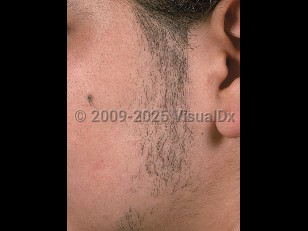Hirsutism
Alerts and Notices
Important News & Links
Synopsis

Hirsutism may be idiopathic, or it may be linked to other conditions. Familial hirsutism is generally facial with a prolonged preauricular hair line. Other etiologies can be considered on the basis of the organ causing the abnormality. Adrenal hirsutism may be due to congenital adrenal hyperplasia or hypercorticism. Causes of increased cortisol include primary nodular hyperplasia, adrenal adenoma, and adrenal carcinoma.
Ovarian hirsutism can be due to polycystic ovary syndrome (PCOS) or ovarian tumors. Pituitary hirsutism is associated with Cushing disease, a prolactin-secreting adenoma, and psychotropic medications that increase prolactin (ie, antipsychotics). Ectopic hormone production, such as the production of ACTH by small cell lung cancer or HCG by choriocarcinoma, also leads to hirsutism. Anabolic steroids lead to the condition as well.
Hirsutism may be associated with seborrhea, acne, and androgenetic alopecia (termed SAHA syndrome). These findings can also be seen in PCOS; however, in SAHA, menstrual cycles are not anovulatory and ovarian ultrasound is unremarkable. HAIR-AN syndrome has also been characterized, which is marked by hyperandrogenemia, insulin resistance, and acanthosis nigricans.
Codes
L68.0 – Hirsutism
SNOMEDCT:
399939002 – Hirsutism
Look For
Subscription Required
Diagnostic Pearls
Subscription Required
Differential Diagnosis & Pitfalls

Subscription Required
Best Tests
Subscription Required
Management Pearls
Subscription Required
Therapy
Subscription Required
Drug Reaction Data
Subscription Required
References
Subscription Required
Last Updated:08/10/2021
 Patient Information for Hirsutism
Patient Information for Hirsutism - Improve treatment compliance
- Reduce after-hours questions
- Increase patient engagement and satisfaction
- Written in clear, easy-to-understand language. No confusing jargon.
- Available in English and Spanish
- Print out or email directly to your patient


